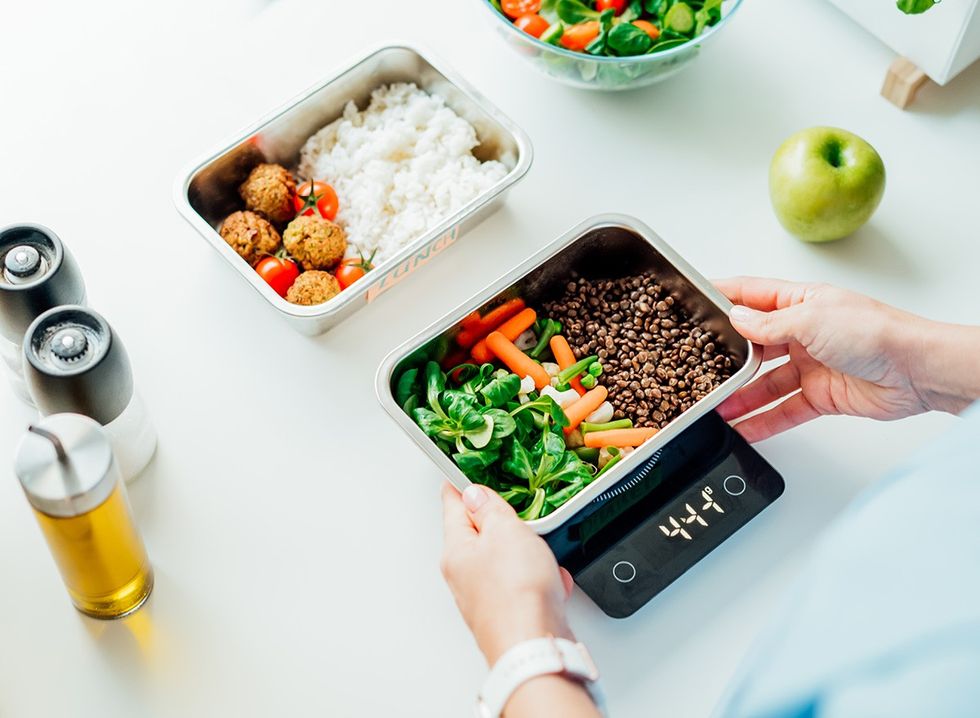Are you trying to lose belly fat? Autumn Bates (@autumbates) is a Clinical Nutritionist with a Master's in Nutrition Human Performance. She is also a social media influencer with hundreds of thousands of followers, known for revealing tips on healthy eating, weight loss, and intermittent fasting. “Losing belly fat specifically tends to be really tricky for a lot of people on their weight loss journey,” she explains. “But when you use these five golden rules, it can help you to absolutely break through that plateau.” She explains that they are helpful in addressing both visceral and belly fat and starts by addressing the differences between them before launching into the rules.
This Is What Belly Fat Is
“First things first, we need to differentiate between visceral fat and belly fat,” she says in her post, admitting that most people believe they are the same thing, but they aren’t. “What most people know as belly fat is the fat that's stored in the subcutaneous level of the body, which means that it's going to be stored just below the skin. This type of belly fat is the type that you usually will visually see. It will feel what you expect typical body fat to feel like, so it might feel a little bit squishy, or you might be able to physically grab it,” she says.
And, Here Is What Visceral Fat Is
Visceral fat is something entirely different. “It still is fat that's stored in the belly area, but visceral fat is stored in the viscera, AKA around the organs. So, visceral fat will look more like a protruding belly, and you actually don't usually see a lot of the fat on the outside when you have a lot of visceral fat. So the belly might feel really hard, but it's protruding because the fat is stored behind the muscle and within the organs themselves,” she explains. “Visceral fat is much more dangerous for your health than belly fat. In fact, you can have a lot of visceral fat but not appear overweight. She explains that “belly fat that's within the body can cause a lot of issues for organs, can make the organs not function as well, can lead to issues like fatty liver or cirrhosis.”
Golden Rule 1: Watch Out for Fructose
The first golden rule is to watch out for fructose. “Fructose is a type of sugar. It makes up half of just regular table sugar. You have glucose and fructose. Glucose can be readily used throughout the body, whereas fructose needs to be broken down by the liver in order to actually use it. And because of this one, we eat a lot of foods that are really rich in fructose. It can essentially clog up the liver and cause the liver to store that extra fructose as fat on the outside of the liver, AKA the visceral fat. So by greatly limiting the amount of fructose that you're eating in a day, it can really help to alleviate that pressure that's on the liver to break that fructose down,” she says.
Avoid Sweetened Drinks and Processed Food
What are the foods highest in fructose? Sweetened drinks “by far the highest level of fructose that you will have,” she says. “Think of things like sodas or sweetened coffee, sweetened teas, and then fruit juice, which will also be high in fructose and energy drinks. Those are really loaded with sugar. Pretty much anything that has a lot of added sugar in it is also going to have a bunch of fructose in there, too. Other processed foods are also going to be pretty high in fructose if it has added sugar. So just by avoiding mostly processed or altered processed foods and sweetened drinks, you're inherently gonna be avoiding a lot of that fructose.”
Golden Rule 2: Walk More and Sit Less
The second golden rule is to make sure that you walk more and sit less. “A study has found that the more you sit, and in this case, they were talking about sitting and watching TV, but that could translate to sitting at a desk or sitting and scrolling through your phone, but the more that you're sitting in general, the more visceral fat that you will accumulate,” she says.
Try Taking Three Short Walks a Day
The study also found that the more you exercise, the less visceral fat that you have, “but just a morning workout won't cut it,” she said. “If you work out in the morning and then you sit for the rest of the day, you can actually still get those negative impacts of sitting all day, which can result in more visceral fat. So, the morning workout is fantastic. But on top of that, walking throughout the day and breaking up those sedentary moments can really help to contribute to reducing the visceral fat.” She breaks up her workouts into “at least three different parts of the day,” she says. In the morning, she goes for a walk, then another at lunchtime, and then after dinner. “You could also use something like a Fitbit that will remind you to get up every hour and get a minimum of 250 steps in, which really helps to make sure that you're not sitting for longer than an hour at a time. And 250 steps is really only like two minutes of walking around.”
Golden Rule 3: Limit Alcohol
The third golden rule is to limit alcohol, as its “impact on visceral fat works pretty similarly to fructose because they both have to be broken down by the liver and if we have a lot of it, it can overload the liver and lead to those visceral fat issues,” she says. “In fact, when you get fatty liver buildup from non-alcoholic sources, it's known as non-alcoholic fatty liver disease. That's going to be more like the sodas and sweetened drinks. Whereas if you get the fat buildup from alcohol, that's known as alcoholic fatty liver disease. They work in a very similar fashion, but both have the end result of increasing fat.”
RELATED: Weight Loss Coach Shares 4 Natural Ways She Lost 12 Pounds After Having Kids
Stick to One to Three Drinks a Week
She adds that drinking alcohol negatively impacts weight loss in general in a few ways. “One is that it really negatively impacts sleep, and poor sleep leads to increased hunger hormones the next day. It also leads to increased cravings for sugary, starchy foods. So, it sets you up for failure the next day after you had alcohol the previous night. That poor sleep can also increase the stress hormone cortisol, which tends to cause weight gain, specifically around the belly,” she says. “Overall, limiting alcohol, and of course, making sure that the alcohol that you do choose is zero or low sugar, is very important when addressing belly fat. So if reducing that visceral or belly fat is a big goal of yours, then really reducing alcohol preferably to no more than one to three drinks per week is a really, really important golden rule.”
Golden Rule 4: Reduce Stress
The fourth golden rule is stress reduction, as high cortisol has been linked to belly fat, “but it's important to know that we can have stressors in multiple different forms,” she says. “It's not just the typical type of emotional stress that most of us are familiar with, but it's also physical stress too. When we're looking to reduce stress levels, it's not really to eliminate it but to balance it because some level of stress is actually good for our body. We just don't want to overdo it. We want times where we get these little spikes of cortisol, but we also want it to naturally come down and have periods of rest and repair as well.”
Don’t Overdo It with Exercise
This is where having a balanced approach to exercise is key. “This is something I notice a lot with people who just really love to exercise, is that they can tend to overdo it. Maybe they're just not having a day off. They're working out every single day. They're running every single day. In order to actually see the benefits of exercise, especially when you're looking at it from strength training or running perspective, we need to have active rest days off where we're just walking and maybe stretching,” she says. She notes that running too much can elevate cortisol levels per science. “We need to make sure that we're actively adding in those active rest days for our body to rest and recover. So, not too much, not too little. We need to find something right in between.”
RELATED: This Coach Stopped Running and Lost Her Puffy Face With 30-Minute Workouts
Golden Rule 5: Eat Protein, Fat, and Fiber
The fifth golden rule is to eat protein, fat, and fiber. “Sugar is a really important thing to reduce when we are focused on losing belly fat, especially visceral fat, which means that reducing the cravings for sugar is a really important step. Eating enough high-quality sources of protein, fat, and fiber helps you raise our satiety hormones, which shuts off cravings for sugar,” she says.
Stick to Quality Protein Sources
“Plus, when we eat enough protein, it helps our body to hold onto muscle during that weight loss process so that you don't get that slower metabolism as you're losing weight,” she says. Also, look for sources of fiber in whole foods. “Studies have found that diets that are low in fiber lead to a lot more visceral fat than those that are higher in fiber. There have also been studies showing that increased intake of quality protein helps lower belly fat as well, and quality is what really matters.” She notes that while peanut butter “technically has protein,” it's “a very poor quality source of protein,” she says. “Make sure that when you are eating protein, fat, and fiber to help achieve a belly fat loss goal, you are really focused on quality sources. And if you enjoyed this article, take advantage of these 15 Quick Ways to Lose Body Fat Percentage in a Week.








 Monitor Your Carbohydrate IntakeShutterstock
Monitor Your Carbohydrate IntakeShutterstock Shutterstock
Shutterstock Shutterstock
Shutterstock Shutterstock
Shutterstock She Lifted WeightsShutterstock
She Lifted WeightsShutterstock Shutterstock
Shutterstock Shutterstock
Shutterstock Lift Heavy WeightsShutterstock
Lift Heavy WeightsShutterstock Gina Knows the Belly “Hang” Well After 7 KidsShutterstock
Gina Knows the Belly “Hang” Well After 7 KidsShutterstock De-StressShutterstock
De-StressShutterstock Shutterstock
Shutterstock






 Don’t Drink as Much AlcoholShutterstock
Don’t Drink as Much AlcoholShutterstock Shutterstock
Shutterstock Shutterstock
Shutterstock Shutterstock
Shutterstock 8. Ice CreamShutterstock
8. Ice CreamShutterstock Shutterstock
Shutterstock Meal PlanningShutterstock
Meal PlanningShutterstock Shutterstock
Shutterstock Trick 2: Strategic Food Tracking for SuccessShutterstock
Trick 2: Strategic Food Tracking for SuccessShutterstock












 I'm a Nutritionist and These 9 High-Protein Snacks Keep My Clients Full While Losing 50 Pounds
I'm a Nutritionist and These 9 High-Protein Snacks Keep My Clients Full While Losing 50 Pounds
 Shutterstock
Shutterstock 2. Processed FoodsShutterstock
2. Processed FoodsShutterstock Shutterstock
Shutterstock Shutterstock/Prostock-studio
Shutterstock/Prostock-studio Shutterstock
Shutterstock Pro TipsShutterstock
Pro TipsShutterstock Shutterstock
Shutterstock Shutterstock
Shutterstock Shutterstock
Shutterstock Shutterstock
Shutterstock Most Women on GLP-1s Are Making a Few Common MistakesShutterstock
Most Women on GLP-1s Are Making a Few Common MistakesShutterstock Soda and Sugary DrinksShutterstock
Soda and Sugary DrinksShutterstock Shutterstock
Shutterstock Eat BreakfastShutterstock
Eat BreakfastShutterstock And Improve Insulin SensitivityShutterstock
And Improve Insulin SensitivityShutterstock Belly Flab Strip Tip: Sugar and Fat Calories Leave Its Mark on Your BodyShutterstock
Belly Flab Strip Tip: Sugar and Fat Calories Leave Its Mark on Your BodyShutterstock Shutterstock
Shutterstock The Drugs Mimic the GLP-1 Hormone Naturally Produced by the BodyShutterstock
The Drugs Mimic the GLP-1 Hormone Naturally Produced by the BodyShutterstock 3. Deep-Fried ItemsShutterstock
3. Deep-Fried ItemsShutterstock